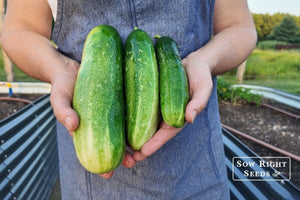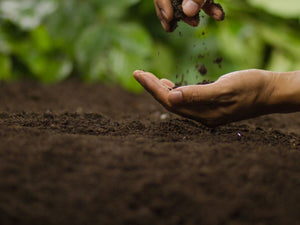How to Grow Vibrant Verbena Flowers That Beat the Summer Heat
VerbenaVibrant Verbena flowers are known for their drought, and heat tolerance, and continuous blooms from spring until fall frost. These colorful flowers are easy to grow and can fill up your flower beds with beautiful blossoms in the spring. But you don’t have to wait. Late fall is the perfect time to plant your Verbena seeds! We’ll cover how, where, and when to grow verbena flowers.

Verbena Flowers
Verbena flowers are popular with gardeners for their heat tolerance and long bloom season. Verbenas are also popular flowers in butterfly and pollinator gardens. The shape and vivid colors draw in butterflies, bees, moths, and hummingbirds. You’ll love adding verbena to your flower garden.
How to plant verbena flowers from seed
The simplest way to plant verbena seeds is to direct sow in the late fall. This may seem counterintuitive with this heat and sun-loving flower, but the cool weather will chill the seeds until the ground warms up in the spring.
Sowing Verbena Seeds Outdoors
Lightly rake the soil and sprinkle the seeds.
Cover with soil to a depth of 1/16”.
By planting outdoors in the fall, the seeds will go through a cold period. This signals to the seed to wait until it warms back up to germinate. This period of cold stratification results in excellent seed germination rates.
You can replicate this natural cold stratification process by placing the seeds in the fridge for ten days before planting. Learn more about cold stratifying seeds.
Sowing Verbena Seeds Indoors
Sow verbena seeds indoors 12-14 weeks before the last frost date.
Place 2 to 3 seeds per growing cell in seed starting mix.
Keep soil moist until seeds germinate. (20 to 40 days)
Soil temperature for germination is 65 - 75ºF.

Verbena seed germination tips
Prior to planting verbena seeds, chill them for 10 days. Although verbena is a heat tolerant flower, the seeds will germinate better if they go through a cold period first.
Keep seeds moist until they sprout. Verbena seeds can take 20 to 40 days to germinate depending on the variety.
When soil temperature reaches 65-75ºF, the seeds will awaken from their dormancy and start sprouting.
Once seeds have germinated, keep the soil moist but not soggy.
Transplanting Verbena plants
Once the verbena seedlings are several inches tall with true leaves, they will be ready for transplanting after they’ve been hardened off. Slowly acclimate your verbena seedlings to outdoor growing conditions.
Transplanting is a good time to pinch back the plant for bushier growth. Cutting off the top growth to the first leaf node will encourage side branching.
Plant verbena seedlings in fertile soil with added compost. Verbena plants are known for growing well in poor soil, but seedlings will get off to a better start when planted in fertile soil.
Space verbena seedlings 12” apart to give them room to grow. Having space for airflow is especially important in humid locations.
Keep seedlings well watered but not soggy. Once verbena plants are established, they can tolerate drought.

Growing Verbena Plants
Light
Verbena needs lots of sun. A location with 8 to 10 hours of daily sunlight is ideal for growing verbena.
Water
Verbena plants are heat and drought-tolerant; however, long stretches of drought and heat will result in fewer blooms. Water regularly, usually about 1 inch of water per week. Water at the roots and avoid watering overhead to prevent powdery mildew.
Soil
Verbena will grow in all kinds of soil. The most important consideration is that it can drain well. Soggy soil will result in root rot.
Pruning & Deadheading
Pruning and deadheading are essential for keeping verbenas healthy and blooming. Deadhead spent flowers to keep the plant producing more blooms. Pruning will keep the plant compact and bushy. Verbena can be cut back in summer, and it will grow and rebloom in 2 to 3 weeks.
Verbena Seeds to Start Growing Now
Ideal Florist Mix Verbena
This heirloom verbena mix is perfect for window boxes, planters, and hanging baskets. The vibrant colors bloom on mounds of green foliage that reach 12 inches tall. Once verbena has reached its maximum height, it will spread out. Pinching back new growth will keep the plants compact.
Mixed Moss Verbena
Moss verbena is a drought-resistant plant with fern-like foliage and clusters of blooms that attract hummingbirds, bees, and butterflies. It is an excellent choice for poor soils or rocky terrain. This tender plant is a perennial in frost-free zones or an annual in cooler climates.
Overwintering Verbena
In growing zones with moderate winters, verbena will continue growing. You can also take cuttings and put them in water. Once the verbena cuttings have roots, you can plant them in pots with soil and then transplant them outdoors in spring.
Solutions for Verbena Pests and Diseases:
Powdery mildew - Keeping the leaves dry is vital for preventing powdery mildew. Apply water to the soil instead of from overhead. Remove parts of the plant with mildew to keep it from spreading.
Botrytis blight - This can be caused when the growing location is too moist. Remove and destroy any infected plants. Avoid applying too much nitrogen and overhead watering.
Aphids - Removing aphids when they first appear will be the most effective deterrent. There are natural ways to get rid of aphids, including homemade sprays.
Snails & slugs - Avoid using heavy and wet mulch around verbena plants. These just encourage more snails and slugs.

Verbena FAQs
Does Verbena come back every year?
Perennial verbena varieties will come back for 2 or 3 years in growing zones with moderate winters. Heirloom verbena will self-seed.
Where is the best place to plant verbena?
Verbena needs 8 to 10 hours of daily sunlight. So, any place with full sun and soil that drains well will be a great spot to grow verbena. It can grow in borders, herb gardens, planters, and hanging baskets.
Does verbena spread?
There are different varieties of verbena plants. Some are very short and will spread more than taller varieties. You can trim verbena as it grows or allow it to spread.
How do you keep verbena blooming all summer?
Removing spent blooms (deadheading) is the best way to keep your verbena plants blooming all summer long. Cutting off the blooms just above the new growth nodes will encourage bushier growth with more flowers.
Verbena flowers are a beautiful addition to any flower garden. Bees, butterflies, and hummingbirds also appreciate them. Verbenas are the plants to grow in hot locations where other flowers fade.
With our proven heirloom seeds, you can start growing vibrant verbena in your garden.
Popular Posts
-

How Can You Tell Cucumbers Are Ripe? Use these tips for the best harvest
-

How to Amend Sandy Soil and Start Growing!







Leave a comment